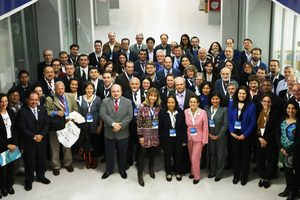Towards usable climate science: Informing decisions and provision of climate services to the agriculture and water sectors of southeastern South America (CRN 3035)

Project information
Universidad de Buenos Aires (Argentina)
Results
This is a summary of the most salient project results. For further information see the project website, project papers or contact the investigators directly.
The team established a quality controlled (QC) weather database to develop climate information products for stakeholders. The project now implemented automatic data updating and preliminary checking every 10 days. The Met Services in the Regional Climate Center for Southern South America (CRC-SAS) ftp their data to the site. The Intergovernmental Committee for the La Plata Basin (CIC) plans to expand this database with a regional hydrological information system.
Published procedures used for QC scripts are implemented in R to make the process open access. Among the QC procedures, spatial tests that use information from neighboring weather stations are most effective. Records flagged as “suspicious” are being verified against official climate records in each country. Corrections are done, without overwriting original, erroneous values. The use of 5 methods for missing data imputation, followed by an “ensemble” calculation taking the mean or median provide more reliable interpolations than any single method.
Data were used for drought maps based on the Standardized Precipitation Index (SPI). 4 other drought indicators:
1) the Standardized Precipitation Evapotranspiration Index (SPEI),
2) precipitation deciles,
3) categories of precipitation levels from Brazil’s INMET, and
4) the percentage of normal precipitation,
automatically determine the timing, duration, and intensity of droughts or water excess. Indices calculated for 1, 3, 6, 12, 18, 24 and 36 months provided animated spatial time-series of droughts.
Linking the meteorological database of the CRC-SAS with crop models allowed yield forecasts for 14 locations in the Argentine Pampas using climate-crop models that include observed data up to the day of the forecast. Correlations between accumulated moisture, consecutive days without rain, and yield in specific regions provided input for index insurance calculations, but also showed the need for a better network of weather stations. Alternative satellite-derived precipitation estimates are being validated and the use of the Global Land Data Assimilation System (GLDAS) to develop soil-moisture monitoring indices is being evaluated.
Integration with long-term weather data showed: opposite phases of the main modes of SST anomalies produce differences larger than 50% in monthly precipitation, with a greater relative impact of the interdecadal oscillations on the extremes of daily rainfall than on moderate rainfall ranges. There were predictable differences between Central and East ENSO influence on La Plata Basin precipitation. Intraseasonal Madden-Julian (MJO) anomalies over South America are important for heavy rainfall over the South Atlantic convergence zone. Management of climate risks and opportunities requires an enhanced capacity to “translate” such climate information and predictions into sector-specific information. This work relied heavily on individual and institutional networking to join expertises.
The monitoring and analysis of the dynamics of cooperation and collaborative production of knowledge between scientists (social and natural) and stakeholders around the provision of climate services in SESA by the recently launched RCC-SSA is a hallmark of the project, in a context where rapid changes in demand for usable and relevant climate information at regional level urge the improvement of governance practices and the promotion of a deeper sectoral involvement.
Outreach
 IAI research project involved in the creation of a drought early-warning system for southern South America
IAI research project involved in the creation of a drought early-warning system for southern South America
 New bridges for the exchange of knowledge Maria Ines Carabajal, a PhD student in an IAI project, shares her experience with the Institute and the opportunities that opened for her.
New bridges for the exchange of knowledge Maria Ines Carabajal, a PhD student in an IAI project, shares her experience with the Institute and the opportunities that opened for her.
 How to communicate climate change? The CRED Guide: The Psychology of Climate Change Communication is available in Portuguese thanks to the joint efforts by this CRN and the network on communication between science and policy (CRN 3106).
How to communicate climate change? The CRED Guide: The Psychology of Climate Change Communication is available in Portuguese thanks to the joint efforts by this CRN and the network on communication between science and policy (CRN 3106).
Development of water excess/deficit soil-moisture-related indices for application in the agricultural and cattle sector
Lead: Andrea Celeste Saulo
Centro de Investigaciones del Mar y de la Atmósfera (CIMA), Buenos Aires
This project on climate services focuses on an under-addressed variable: soil moisture. The assumption is the existence of soil-atmosphere coupling, particularly in some areas of the Pampas region and at moments when climate indices such as El Niño and La Niña are in neutral phase. The project examines how surface status affects rainfall occurrence. The expected product is a water excess/deficit index based on soil moisture information derived from the Global Land Data Assimilation System (GLDAS). The index is expected to be more sound than the existing ones and to have direct application in agricultural decision-making in the Argentine Pampas and the south of South America.
Project investigators
Cecilia Hidalgo (cecil.hidalgo@gmail.com)
Universidad de Buenos Aires, Argentina
Alice Grimm (grimm@fisica.ufpr.br)
Universidade Federal do Parana, Brazil
Dirceu Herdiez (dirceu.herdies@cptec.inpe.br)
CPTEC, Brazil
Renzo Taddei (renzotaddei@gmail.com)
Universidade Federal do Rio de Janeiro, Brazil
Julian Baez (baez.julian@gmail.com)
Dirección Nacional de Meteorología, Paraguay
María Helena Fernández Long (flong@agro.uba.ar)
Facultad de Agronomía, UBA, Argentina
Roberto De Ruyver (rderuyver@cnia.inta.gov.ar)
Instituto Nacional de Investigaciones Agropecuarias (INTA), Argentina
Daniel Lema (danilema@correo.inta.gov.ar)
INTA Instituto de Economía y Sociología, Argentina
Mónica Marino (marino@smn.gov.ar)
Servicio Meteorológico Nacional, Argentina
Ángel Menendez (angel.menendez@speedy.com.ar)
Instituto Nacional del Agua, Argentina
Sandra Occhiuzzi (socchi@minagri.gob.ar)
Oficina de Riesgo Agropecuario, Argentina
Fernando Ruiz Toranzo (fruiztoranzo@crea.org.ar)
AACREA, Argentina
Celeste Saulo (saulo@cima.fcen.uba.ar)
Facultad de Ciencias Exactas y Naturales, UBA, Argentina
Maria Skansi (mms@smn.gov.ar)
Servicio Meteorológico Nacional, Argentina
Hernan Urcola (hurcola@balcarce.inta.gov.ar)
INTA Balcarce, Argentina
Mauricio Fernandes (mauricio@cnpt.embrapa.br)
EMBRAPA Passo Fundo, Brazil
Lauro Guimaraes Fortes (lauro.fortes@inmet.gov.br)
Instituto Nacional de Meteorologia, Brazil
Antonio Divino Moura (diretor.inmet@inmet.gov.br)
Instituto Nacional de Meteorologia, Brazil
Wellington Pavan (pavan@upf.br)
Universidade do Passo Fundo, Brazil
Fabricio Silva (fabricio.silva@inmet.gov.br)
Instituto Nacional de Meteorologia, Brazil
Hector Causarano (hector.causarano@agr.una.py)
Universidad Nacional de Asunción, Paraguay
Edgar Mayeregger (shalom19@gmail.com)
Ministerio de Agricultura, Paraguay
Max Pasten (maxpasten@gmail.com)
Universidad Nacional de Asunción, Paraguay
Hugo Berbery (berbery@atmos.umd.edu)
University of Maryland, USA
Guillermo Podesta (gpodesta@rsmas.miami.edu)
University of Miami, USA
Students
Alexandre Arias, Undergraduate, Universidade Federal do Parana, Brazil
Ana Lugo, Undergraduate, Universidad Catolica Nuestra Señora de la Asunción, Paraguay
Andrea Samudio, Undergraduate, Universidad Catolica Nuestra Señora de la Asunción, Paraguay
Anna Paula Peres, PHD, Universidad Federal de San Pablo, Brazil
Beatriz C. Bispo, Undergraduate, Universidade Federal do Parana, Brazil
Caroline B. Gama, Undergraduate, Universidade Federal do Parana, Brazil
Cristian Salinas, Undergraduate, Universidad Nacional de Asunción, Paraguay
Diana Benitez, Undergraduate, Universidad Nacional de Asunción, Paraguay
Edith Ruth Diaz, Undergraduate, Universidad Nacional de Asunción, Paraguay
Eduardo M. Machado, Undergraduate, Universidade Federal do Parana, Brazil
Eladio Javier Torres, Undergraduate, Universidad Nacional de Asunción, Paraguay
Fabricio Schiavon Kolberg, Undergraduate, Universidade Federal do Parana, Brazil
Fiorella Oreggioni, Undergraduate, Universidad Catolica Nuestra Señora de la Asunción, Paraguay
Gisele P. Martins, Undergraduate, Universidade Federal do Parana, Brazil
Joao Gerd Z. de Mathos, PHD, Centro de Previsão de Tempo e Estudos Climáticos, Brazil
Jose Manuel Mazo, Undergraduate, Universidad Catolica Nuestra Señora de la Asunción, Paraguay
Leandro Sgroi, PHD, Universidad Nacional del Litoral, Argentina
Luis Alberto Blacutt Benavides, PHD, CPTEC, Bolivia
Maria Ines Carabajal, PHD, Universidad de Buenos Aires, Argentina
Michael Wesley Sabino Da Silva, Undergraduate, Universidade Federal do Parana, Brazil
Nathalia Clyo Rizzo de Freitas Neves, Universidad Federal de Sao Paulo, Brazil
Nicole C. Laureanti, Undergraduate, Universidade Federal do Parana, Brazil
Omar Muller, PHD, Universidad Nacional del Litoral, Argentina
Pablo Spenneman, PHD, CIMA-CONICET, Argentina
Pamela Scanio, Undergraduate, Universidad de Buenos Aires, Argentina
Regina Aguilera, PHD, Universidad de Buenos Aires, Argentina
Ricardo Pereira, Undergraduate, Universidad Autonoma de Asuncion, Paraguay
Ruth Escobar, Undergraduate, Universidad Catolica Nuestra Señora de la Asunción, Paraguay
Executive summary
Climate variability and change affect a variety of societal sectors, regions and issues − including sustainable development, poverty mitigation and food security. Decision makers at many levels–households, communities, regions and countries– will need usable information that combines state-of-the-art climate science with an integrative understanding of the dynamics of affected social-ecological systems. Existing institutional arrangements seem insufficient to provide the comprehensive and credible knowledge needed. Thus there is growing interest in “climate services” − defined as “the timely production and delivery of useful climate data, information, and knowledge to decision makers.”
The objectives of this project are to: (i) conduct research and outreach to inform resilient decision-making in climate-sensitive sectors such as agricultural production and water resources management in southeastern South America, one of the major food-producing regions in the world, and (ii) facilitate sustainable societal adaptation to a shifting and changing climate. Project activities are organized around four main research foci: (1) the production, interpretation, assessment, and synthesis of diagnostic and forecast climate information on multiple time scales; (2) “tailoring,” communication, and dissemination of that information; (3) “translation” of climate information into plausible impacts and outcomes (including ranges of uncertainty or credibility) of viable adaptive actions in agricultural production and water management; (4) exploration of the institutional structures needed to support the provision of climate services.
Since the early stages of the project, a wide range of relevant stakeholders will work closely with CRN researchers at universities and mission-oriented agencies in designing the agenda and outreach. The research will be tightly interwoven with educational and outreach programs designed to train versatile scientists and practitioners able to work comfortably in interdisciplinary teams, navigate the interface between science and society, and produce, communicate and use credible and usable climate information.
The project will focus on southern Brazil, eastern Paraguay and central-eastern Argentina. The regional scale is chosen because climate impacts and feedbacks are most strongly perceived at regional and local scales: these levels are where adaptation will occur and where climate services will be delivered. This multi-national, multi-disciplinary network will contribute to provide a solid foundation for a Regional Climate Center (RCC) proposed to the U.N. World Meteorological Organization.

